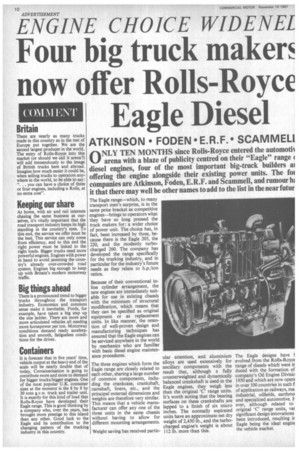Four big truck makers now offer Rolls-Royce Eagle Diesel
Page 12

If you've noticed an error in this article please click here to report it so we can fix it.
ATKINSON • FODEN • E. R. F. • SCAMMELI
ONLY TEN MONTHS since Rolls-Royce entered the automotii arena with a blaze of publicity centred on their "Eagle" range ( diesel engines, four of the most important big-truck builders al offering the engine alongside their existing power units. The fot companies are Atkinson, Foden, E.R.F. and Scammell, and rumour h: it that there may well be other names to add to the list in the near futur
Britain
There are nearly as many trucks made in this country as in the rest of Europe put together. We are the second largest producer in the world. The entry of Rolls-Royce into this market (or should we call it arena?) will add tremendously to the image of British trucks here and abroad. Imagine how much easier it could be, when selling trucks to operators anywhere in the world, to be able to say: ". . . you can have a choice of three or four engines, including a Rolls, at no extra cost".
Keeping our share
At home, with air and rail interests chasing the same business as ourselves, it's vitally important that the road transport industry keeps its high standing in the country's eyes. To this end, the service we offer must be the best. This service can only come from efficiency, and to this end the right power must be linked to the right loads. Bigger trucks need more powerful engines. Engines with power in hand to avoid jamming the country's already over-crowded road system. Engines big enough to keep up with Britain's modern motorway traffic.
Big things ahead
There is a pronounced trend to bigger trucks throughout the transport industry. Economics and common sense make it inevitable. Fords, for example, have taken a big step up the size ladder. There are more and more articulated vehicles all needing more horsepower per ton. Motorway conditions demand ready acceleration and smooth, fatigueless conditions for the driver.
Containers
It is forecast that in five years' time, vehicle output at the heavy end of the scale will be nearly double that of today. Containerisation is going to contribute more and more to demand for bigger trucks/bigger engines. One of the most popular U.K. container sizes at the moment is the 8 by 8 by 30 tons g.v.w truck and trailer unit. It is exactly for this kind of load that Rolls-Royce have developed their Eagle range. This is good thinking by a company who, over the years, has brought more prestige to this island than any other. Good luck to the Eagle and its contribution to the changing pattern of the trucking industry in this country.
The Eagle range—which, to many transport men's surprise, is in the same price bracket as competitive engines—brings to operators what they have so long pressed the truck makers for: a wider choice of power unit. The choice has, in fact, been increased by three, because there is the Eagle 205, the 220, and the modestly turbocharged 260. The company has developed the range specifically for the trucking industry, and in particular for the industry's future needs as they relate to h.p./ton ratios.
Because of their conventional inline cylinder arrangement, the new engines are immediately suitable for use in existing chassis with the minimum of structural modification, which means that they can be specified as original equipment or as replacement units. In like manner, the retention of well-proven design and manufacturing techniques has ensured that the Eagle engines can be serviced anywhere in the world by mechanics who are familiar with basic diesel engine maintenance procedures.
The three engines which form the Eagle range are closely related to each other, sharing a large number of common components, including the crankcase, crankshaft, camshaft, liners, etc., and the principal external dimensions and weights are therefore very similar. This means that a vehicle manufacturer can offer any one of the three units in the same chassis without having to allow for different mounting arrangements.
Weight saving has received partic ular attention, and aluminium alloys are used extensively for ancillary components with the result that, although a fully counterweighted and dynamically balanced crankshaft is used in the Eagle engines, they weigh less than the original 'C' range units. It's worth noting that the bearing surfaces on these crankshafts are lapped to a finish of six micro inches. The normally aspirated units have an approximate net dry weight of 2,450 lb., and the turbocharged engine's weight is about 112 lb. more than this.
The Eagle designs have l evolved from the Rolls-Royce range of diesels which' were it duced with the formation of company's Oil Engine Divisic 1950 and which are now opera in over 100 countries in such f of application as railways, ma industrial, oilfields, earthmo and specialized automotive. F ever, although related to original 'C' range units, vat significant design innovations been introduced, resulting ir Eagle being the ideal engin( the vehicle market.




































































































































































































































































